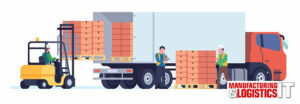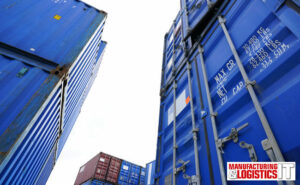Manufacturing and Supply Chain IT articles comprising case studies, product information, opinion articles, reports, new contract wins, product launches, opinion from the trade associations, government departments, research analysts, the vendor community. These articles are about specific industry IT solutions and topics relating to how improvements and efficiency gains can be made by the use of information technology within supply chain applications. All topics are covered in these articles which include ERP/MRP, Manufacturing Software, Advanced Planning, Demand Forecasting, Supply Chain Management, Warehouse Management Software, Automatic Identification/Datacapture, Voice-Directed Warehousing, Printing & Labelling, Transport Management, Asset Management Software and Mobile Computing.
Dec 19, 2023 <!--Comments (0)-->

Cultural competency isn't just a valuable asset in logistics and manufacturing; it's the key that unlocks doors to international expansion. Global BPO firm, Acquire BPO’s, recent expansion to the US exemplifies the true value in cultural competency. Their expansion to Irving, TX is expected to bring more than 130 jobs to the region.
Dec 19, 2023 <!--Comments (0)-->

The peak season is renowned for Christmas cheer, retail opportunity, in store shopping, bustling shopping centres and queues. Additionally, shoppers and restaurant clientele are busy. They detest queues. Their time is precious. They have places to go and people to see. They often have many gifts and goods to buy for family and friends through the Christmas period – and, they often want to relax in a restaurant or food and beverage establishment in between their shopping too.
Dec 19, 2023 <!--Comments (0)-->

Digital twin technology represents a quicker and more cost-effective route to market for new products. It is one of the fastest growing segments in engineering, with analysts McKinsey & Co forecasting that the global market for digital twin tech will grow by about 60 percent annually, reaching USD 73.5 billion by 2027.
Dec 19, 2023 <!--Comments (0)-->

Artificial intelligence (AI) is unlikely to be the next big trend in the retail and e-commerce sector after new analysis found it ranks bottom in the proportion of job vacancies requiring AI skills.
Dec 19, 2023 <!--Comments (0)-->

By Ray Hunter, freelance writer.
Career opportunities abound in the transportation and logistics sector, vital to worldwide economies. As a result, many truck driving schools across the country offer high-quality training programs to prepare aspiring truck drivers for a successful career in the logistics industry.
Logistics Information Technology News (LogisticsIT.com)
Logistics information technology (LIT) is the use of information technology (IT) to improve the efficiency and effectiveness of logistics operations. LIT encompasses a wide range of technologies, including:
- Barcoding and electronic data interchange (EDI): These technologies are used to automate the exchange of data between different parts of the supply chain.
- Warehouse management systems (WMS): These systems are used to track inventory levels, manage orders, and optimize the flow of goods in and out of warehouses.
- Transportation management systems (TMS): These systems are used to plan and track shipments, manage carriers, and optimize routes.
- Fleet management systems (FMS): These systems are used to track and monitor vehicles, manage fuel consumption, and improve driver safety.
- Geospatial technologies: These technologies are used to track the location of goods in real time and optimize delivery routes.
- Artificial intelligence (AI): AI is being used in logistics to automate tasks, improve decision-making, and optimize operations.
LIT can help logistics organizations to improve their performance in a number of ways, including:
- Increased efficiency: LIT can help to automate tasks, streamline processes, and improve communication between different parts of the supply chain. This can lead to significant reductions in costs and improved efficiency.
- Improved visibility: LIT can help to track the location of goods in real time and provide visibility into the entire supply chain. This can help to identify and resolve problems more quickly and improve customer satisfaction.
- Enhanced decision-making: LIT can help to provide decision-makers with real-time data and insights. This can help them to make better decisions about things like inventory levels, shipping routes, and pricing.
- SEO Powered Content & PR Distribution. Get Amplified Today.
- PlatoData.Network Vertical Generative Ai. Empower Yourself. Access Here.
- PlatoAiStream. Web3 Intelligence. Knowledge Amplified. Access Here.
- PlatoESG. Carbon, CleanTech, Energy, Environment, Solar, Waste Management. Access Here.
- PlatoHealth. Biotech and Clinical Trials Intelligence. Access Here.
- Source: https://www.logisticsit.com/articles/2023/12/19/beyond-borders-acquire-bpo’s-us-expansion-is-a-masterclass-in-cultural-competency
- :is
- 13
- 130
- 19
- 23
- 27
- 29
- 32
- 33
- 39
- 3PL
- 40
- 60
- 73
- 80
- a
- About
- acquire
- across
- Additionally
- After
- AI
- analysis
- Analysts
- and
- Announcements
- Annually
- applications
- ARE
- articles
- AS
- aspiring
- asset
- associations
- automate
- BE
- being
- BEST
- Better
- between
- BEVERAGE
- Beyond
- Big
- Billion
- borders
- Bottom
- bring
- bustling
- busy
- button
- buy
- by
- Calendar
- CAN
- Career
- carriers
- case
- Case Studies
- centres
- chain
- chains
- Christmas
- clientele
- Cloud
- CO
- collaboration
- collaborative
- COM
- comments
- Communication
- community
- comprising
- consumption
- contract
- cost-effective
- Costs
- country
- covered
- CRM
- cultural
- customer
- Customer satisfaction
- data
- Decision Making
- decision-makers
- decisions
- delivery
- departments
- description
- different
- digital
- digital twin
- direct
- distribution
- does
- doors
- driver
- drivers
- driving
- e-commerce
- economies
- edi
- effectiveness
- efficiency
- Electronic
- encompasses
- end
- Engineering
- Enterprise
- Entire
- entry
- ERP
- establishment
- Ether (ETH)
- Excellence
- exchange
- execution
- executive
- exemplifies
- expansion
- expected
- family
- fastest
- fastest growing
- Firm
- flow
- food
- For
- found
- freelance
- freight
- friends
- from
- Fuel
- Gains
- General
- gifts
- Global
- global market
- Go
- goods
- Government
- Grow
- Growing
- Have
- help
- high-quality
- How
- HTTPS
- hunter
- identify
- image
- improve
- improved
- improvements
- in
- include
- Including
- industry
- information
- information technology
- insights
- Intelligence
- interchange
- International
- into
- inventory
- isn
- IT
- Job
- Jobs
- journey
- jpg
- just
- Key
- Label
- Labels
- launches
- lead
- Leadership
- levels
- like
- location
- logistics
- made
- make
- manage
- management
- Manufacturers
- manufacturing
- many
- Market
- Masterclass
- mastery
- Matter
- McKinsey
- Mobile
- Monitor
- more
- New
- new products
- news
- next
- number
- of
- offer
- often
- ONE
- Operations
- Opinion
- opportunities
- Opportunity
- Optimize
- or
- orders
- organizations
- out
- over
- parts
- Peak
- People
- percent
- performance
- period
- pieces
- Places
- plan
- planning
- plato
- Plato Data Intelligence
- PlatoData
- position
- Post
- practice
- Precious
- Prepare
- pricing
- printing
- problems
- processes
- Product
- Product information
- Products
- Programs
- proportion
- provide
- quicker
- quickly
- range
- ranks
- RAY
- reaching
- real
- real-time
- real-time data
- recent
- reductions
- region
- Relax
- Renowned
- Reports
- represents
- research
- resolve
- resource
- restaurant
- result
- retail
- Route
- routes
- s
- SaaS
- Sacramento
- Safety
- satisfaction
- School
- Schools
- Season
- sector
- see
- segments
- Shipping
- Shoppers
- Shopping
- significant
- skills
- slow
- Software
- Solutions
- specific
- store
- streamline
- studies
- successful
- supply
- supply chain
- Supply Chain Execution
- supply chain management
- Supply chains
- Systems
- T
- TAG
- tasks
- tech
- Technologies
- Technology
- technology news
- than
- that
- The
- their
- Them
- thermal
- These
- they
- things
- third-party
- this
- thought
- thought leadership
- Through
- time
- to
- too
- Topics
- track
- trade
- Training
- transport
- transportation
- Trend
- truck
- true
- true value
- twin
- TX
- Uk
- unlikely
- unlocking
- unlocks
- URL
- us
- USD
- use
- used
- Valuable
- value
- Vehicles
- vendor
- visibility
- vital
- want
- Warehousing
- ways
- What
- What is
- which
- why
- wide
- Wide range
- will
- Wins
- with
- within
- WMS
- worldwide
- writer
- zephyrnet













